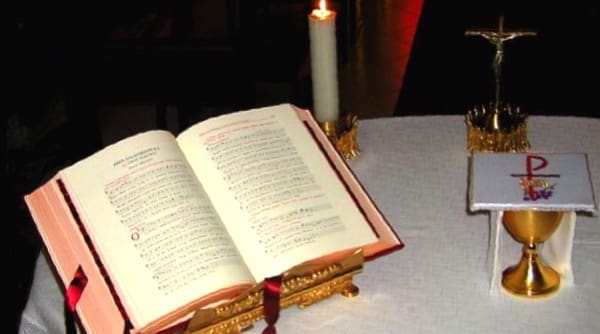The Need for a Liturgical Conscience —
and Where to Get One
Part III of III
Editor’s Note: In Part I, Christopher Carstens introduced the idea that we need to develop a liturgical conscience. In Part II, he described the first five on the “10 Commandments of the Liturgical Life”. Today, he will examine commandments six through ten.
10 Commandments of the Liturgical Life (continued)
6. The Liturgy Announces the Church
The Church is and does many things, but she is most visibly herself at the celebration of the liturgy, especially when the diocesan priest par excellence celebrates at his Mother Church. As the Constitution says, “All should hold in great esteem 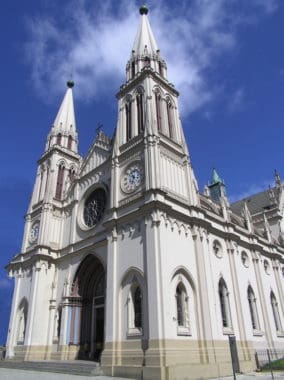 the liturgical life of the diocese centered around the bishop, especially in his cathedral church; they must be convinced that the pre-eminent manifestation of the Church consists in the full active participation of all God’s holy people in these liturgical celebrations, especially in the same Eucharist, in a single prayer, at one altar, at which there presides the bishop surrounded by his college of priests and by his ministers” (n.41; also n.2).
the liturgical life of the diocese centered around the bishop, especially in his cathedral church; they must be convinced that the pre-eminent manifestation of the Church consists in the full active participation of all God’s holy people in these liturgical celebrations, especially in the same Eucharist, in a single prayer, at one altar, at which there presides the bishop surrounded by his college of priests and by his ministers” (n.41; also n.2).
The Church is the Mystical Body of Christ, and as Jesus’ Paschal work most identified him, so now the Paschal Mystery celebrated in the Church’s sacraments most reveal her.
Does your parish’s liturgical assembly reflect the Mystical Body of Christ? Do the ushers know they are Christ’s hands, the choir his voice, the priest his head, the assembly an extension of his flesh and bones in the world?
7. The Liturgy Expresses and Causes Unity
In the first paragraph of the Council’s first document—which happens to be on the liturgy—the Fathers state four principal intentions, one of which is “to foster whatever can promote union among all who believe in Christ.”
Union, even while allowing legitimate diversity, has always been a hallmark of the Latin Church—the only “self-governing” Church of the West, compared to the 21 Catholic Churches of the East.
The first of the Constitution’s practical norms, in fact, is an expression of the Council’s—and the liturgy’s—desire for unity, when it says that no one, “even if he be a priest, may add, remove, or change anything in the liturgy on his own authority” (n.22).
Are my own “principle aims” like those of the Second Vatican Council: expressing and fostering unity within the parish and diocese?
8. The Liturgy is a Foretaste of Heaven
The liturgy looks both forward and back. The worshiping Church remembers Christ and the events of salvation (the term here is “anamnesis”) with a memory powerful enough to make these present here and now. But she also looks above and 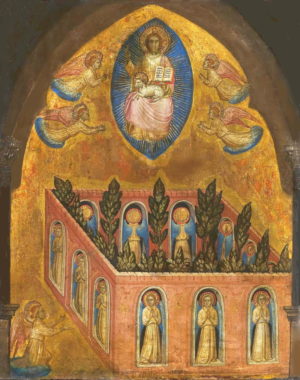 ahead to that full consummation of the victorious Christ’s work, drawing it back down to today’s celebration.
ahead to that full consummation of the victorious Christ’s work, drawing it back down to today’s celebration.
“In the earthly liturgy,” says the Constitution, “we take part in a foretaste of that heavenly liturgy which is celebrated in the holy city of Jerusalem toward which we journey as pilgrims, where Christ is sitting at the right hand of God, a minister of the holies and of the true tabernacle; we sing a hymn to the Lord’s glory with all the warriors of the heavenly army; venerating the memory of the saints, we hope for some part and fellowship with them; we eagerly await the Savior, Our Lord Jesus Christ, until he, our life, shall appear and we too will appear with Him in glory.” (n.8)
Is your parish’s worship “out of this world,” even while firmly rooted on the ground? Are you, your family, neighbors, and pastor aware that, more than a social gathering, your liturgical assembly should be reaching into heaven even as heaven reaches into Sunday’s pews and aisles?
9. The Liturgy is Radiantly Beautiful
Much hay has been made about the supposed conciliar pronouncement that all liturgical art and architecture are to be “characterized by a noble simplicity.” Even though the sale of beige paint may have increased by an unfortunate misreading of this statement, such “noble simplicity” is not a blank minimalism. In fact, “noble simplicity” doesn’t apply to art and architecture at all. Rather, as the Constitution puts it, bishops, “by the encouragement and favor they show to art which is truly sacred, should strive after noble beauty rather than mere sumptuous display” (n.124).
In a similar, yet distinct, section of the Constitution, the Council Fathers call for the rites, rather than art and architecture, to possess “noble simplicity.” Yet this too can mislead without a proper understanding of the principles involved. The Latin text describes the liturgical rites as “nobili simplicitate fulgeant.” The Latin fulgeant means “let them shine,” thus the rites ought to shine with a simplicity that makes their content—Jesus—known. The Latin noun derivative is fulgor, meaning a “flash of lightning.” The liturgy, it appears, ought to resemble the moment of Jesus’ transfiguration, communicating in a flash of brilliance Christ’s glory to his three apostles.
Are your own liturgical tastes illumined by divine radiance?
10. The Liturgy Sings the Word
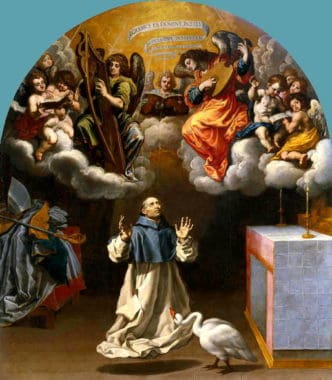 Some enjoy music because of the tune, while others are drawn to the words. The Church is the latter, principally because her Savior and Head is the Word. Her lungs filled with the breath of the Holy Spirit, she sings to and through the Word unto the Glory of God the Father. She is, in the words of Pope Benedict, the true glossolalia, the “new tongue,” her music like “drunken” (that is, Spirited) “speech” (Word).
Some enjoy music because of the tune, while others are drawn to the words. The Church is the latter, principally because her Savior and Head is the Word. Her lungs filled with the breath of the Holy Spirit, she sings to and through the Word unto the Glory of God the Father. She is, in the words of Pope Benedict, the true glossolalia, the “new tongue,” her music like “drunken” (that is, Spirited) “speech” (Word).
Hence, “as sacred song united to the words, it forms a necessary or integral part of the solemn liturgy” (Constitution on the Sacred Liturgy, 112). What the Fathers mean here—as evidenced in the musical legislation both before and after the Council—is that music is not an “extra,” but essential. The words of the rite are enhanced by the breath of the ministers and assembly.
How much of your liturgy is sung? Would you describe your parish’s liturgical music program as essential or as nice add-on?
A Liturgical Life to the Full
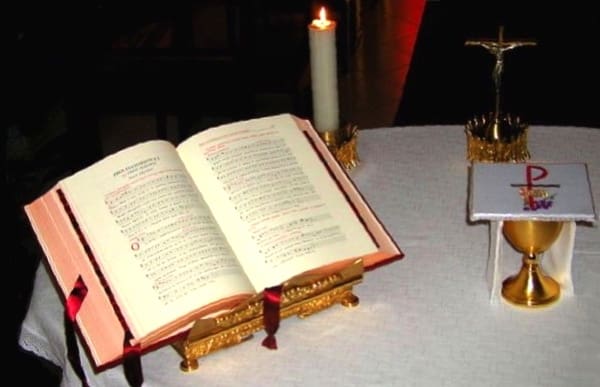 The above list [in today’s and last week’s post], distilled from the Constitution on the Sacred Liturgy, will not answer every liturgical conundrum or solve every liturgical dispute (whether these take place with another or within oneself). But these principles and norms do form a Magisterial framework for liturgical comprehension, participation, and celebration.
The above list [in today’s and last week’s post], distilled from the Constitution on the Sacred Liturgy, will not answer every liturgical conundrum or solve every liturgical dispute (whether these take place with another or within oneself). But these principles and norms do form a Magisterial framework for liturgical comprehension, participation, and celebration.
Take any example you like and measure it against the above-named principles. Do the Mass’s servers at your parish, for instance, glorify God and help me become a saint? Am I singing a particular song in a certain manner, to take another example, so that Jesus himself might be heard (and not me)? Here’s another point in question: are decisions about the altar’s construction concerned with it as a reflection of heaven? However you might respond to these problems, what I like or don’t like, that is, my personal preference, has next to nothing to do with the right answer to these questions.
Like the Christian moral code, the laws of the liturgical cult cultivate a life to the full, a life in abundance, a life reaching from earth to heaven. The Constitution’s norms are codified in the Church’s rites, instructions, and rubrics. Far from restrictive, these create an environment for us to encounter Christ and, like the disciples at the transfiguration, soak up his radiance and grace.
Pope Benedict has named sanctity and beauty as the most convincing apologetic in today’s world.[i] While not the only place in Catholic life in which sanctity and beauty play a vital role, the liturgy rightly celebrated and prayed sanctifies and beautifies like nothing else. An informed liturgical conscience, like a well-formed moral conscience, is a key ingredient to such a liturgical life.
+
[i] Message of His Eminence Cardinal Joseph Ratzinger to the Communion and Liberation meeting at Rimini, August 2002.
+
Art for this post on The Need for a Liturgical Conscience: modified Metropolitan Cathedral, the Basilica of Nossa Senhora da Luz in Curitiba (Metropolitan Cathedral, The Basilica of Our Lady of Light in Curitiba [Brazil]), Morio, 3 January 2006 own work, CCA-SA 3.0 Unported; partial restoration of The Heavenly Jerusalem, Jacobello Aberegno, 1375-1397, PD-US author’s life plus 70 years or less; Aparición de ángeles músicos a san Hugo de Lincoln (Apparition of musical angels to Saint Hugo of Lincoln), Vicente Carducho (Vicenzo Carducci) 1578-1638, undated, PD-US author’s life plus 100 years or less; Missale Romanum, photographed by Lima, 24 September 2006, CCA-SA 2.5 Generic; all Wikimedia Commons.



